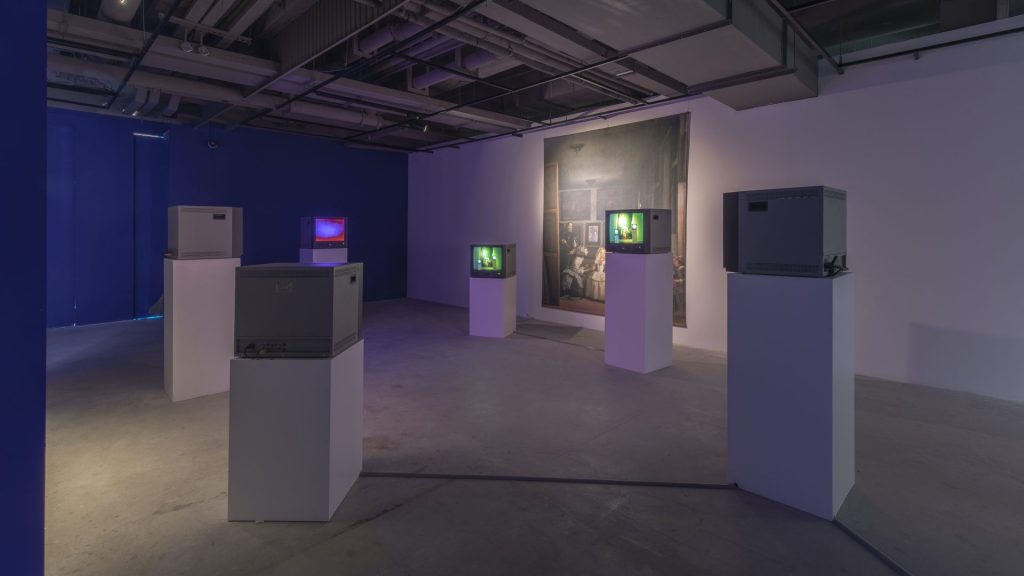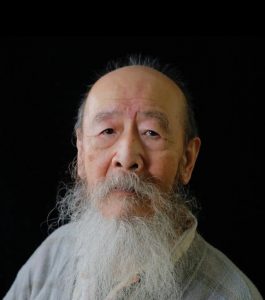Las Meninas, 1974-75
CCTV video installation

Katsuhiro Yamaguchi, Las Meninas, 1974-1975, CCTV video installation
Installation view of Refocusing on the medium: the Rise of East Asia Video Art. Image courtesy of OCAT Shanghai.
Katsuhiro Yamaguchi’s explicit intention in his earliest experiments with the video medium was to open up new ways to communicate with the viewer by incorporating the viewers’ presence into the mediated ‘liveness’ of CCTV technology. Demonstrating the international nature of the experiments with the video medium, this prescient work by Yamaguchi can be counted to be among the first wave of interactive video installations globally. Yamaguchi constructed several video versions of the painting by Diego Velázquez Las Meninas (1656) using colour and black and white reproductions, CCTV and recorded video close ups of the painting. Through the medium of video, Yamaguchi expands the already complex relationship between the viewer and the sight lines within Velázquez’s self-portrait as the royal court painter. The Spanish artist’s deconstructive approach to representation, revealing power structures and the process of painting the painting, is one of the most discussed elements of this famous work. Notably Yamaguchi’s Las Meninas replaces one of the King and Queen’s portrait with a CCTV camera contemporising the symbol of power and surveillance.
In Yamaguchi’s video version, the meeting of classical baroque painting genre and electronic media embodies a revolutionary reorganisation of representation through the medium of video. By physically moving around Yamaguchi’s Las Meninas installation, we experience multiple thresholds between the act of observing and being observed; being part of the work and separate to it. Our role is a dynamic changing element, where we can sequentially or simultaneously consider being a passive spectator, an active participant, a central or decentralised subject of, or an object in, the art work. The reproduction of the 17th century painting and the CCTV live representation of our own image come together in a virtual expression, but also as an actual contemporary spatial moment. (Text / Kim Machan)

Image: Portrait of Katsuhiro Yamaguchi, 2015 Image courtesy of Saitô Sadamu
- Katsuhiro Yamaguchi
1928-2018, Tokyo, Japan
Born in Tokyo, Japan in 1928, Katsuhiro Yamaguchi created over 30 major video installations since 1974. A prolific artist and educator, he began his career establishing the pioneering art group Jikken Kôbô (Experimental Workshop) 1951-1958. Yamaguchi experimented in the field of ‘art and technology’ and ‘electronic arts’, and in 1971 founded the highly influential artist collective Video Hiroba. In 1977, he founded Sogô zôkei (Visual arts and mixed media) department in University of Tsukuba. He travelled to Europe and the United States for short tours, was a colleague of Yoko Ono and had contact with the fluxus art movement. His first sculptures in the 1950s, utilising transparent textured glass angled to provoke movement known as the ‘Vitrine’ series preceded his moving image experiments and installations. His interactive CCTV performances and installations experiments began in 1972 using the Sony Portapak in public places and galleries. In 1975 his work was awarded the leading prize at the San Paolo Biennale for his interactive CCTV video installation Las Meninas 1974-75. Katsuhiro Yamaguchi exhibited extensively throughout his career both nationally and internationally.

